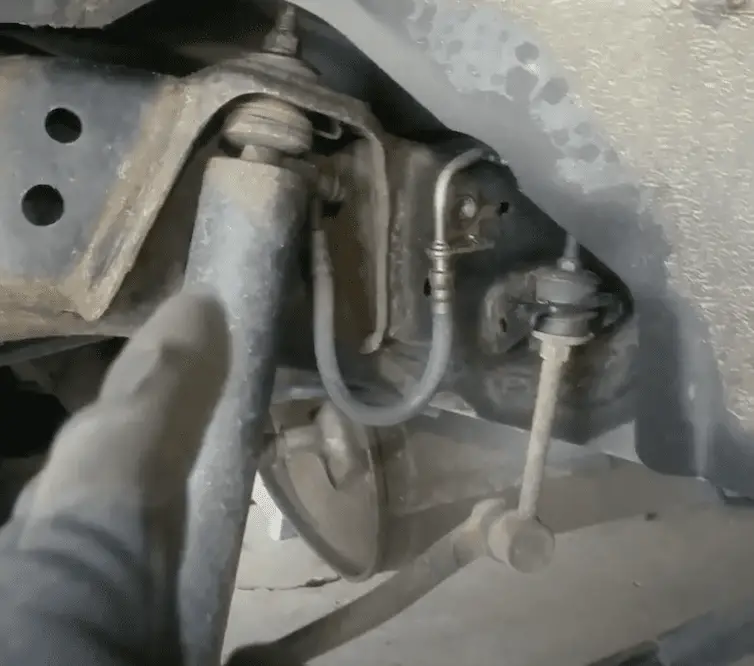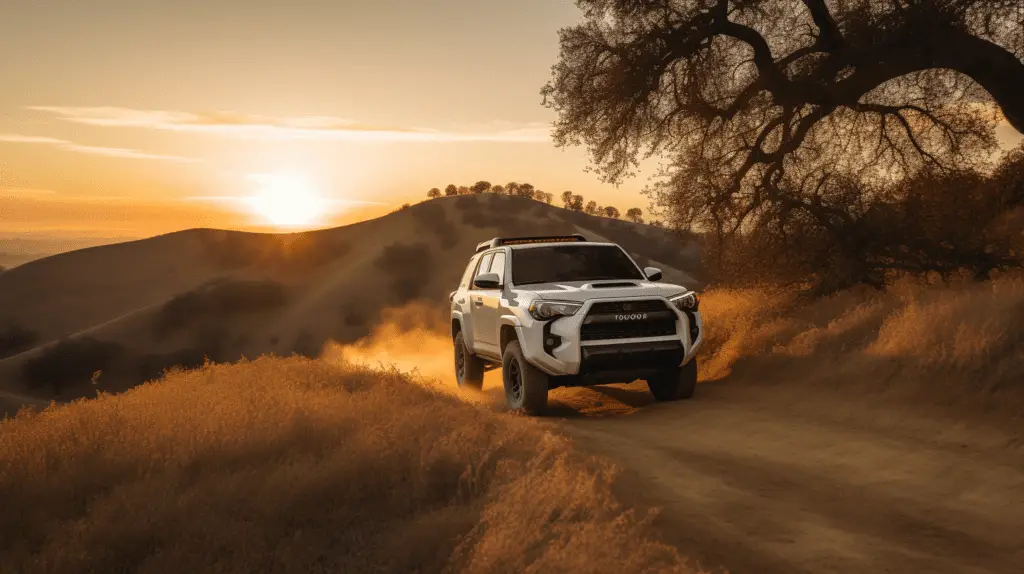What is KDSS?
KDSS is Toyota’s so-called “Adaptive Suspension” system and stands for Kinetic Dynamic Suspension System. It’s not an entirely different suspension system but rather an additional system to boost performance.
KDSS is essentially a hydraulic system of two pistons attached to the front and rear sway bars respectively. It is a passive system that allows for more wheel articulation offroad but still maintains good traction, stability and body roll mitigation when driving on the street. You basically get the best of both worlds (for the most part).
What does the Kinetic Dynamic Suspension System do?
In order to understand what the KDSS does you first need to understand what Sway Bars do.
Sway bars
A sway bar, also known as a stabilizer bar or anti-roll bar, is a component of a vehicle’s suspension system that helps to reduce the amount of body roll or sway that occurs when a vehicle turns or goes over uneven terrain. The sway bar is a metal bar that is connected to the suspension on both sides of the vehicle. There are typically both front and rear sway bars.
When one side of the vehicle’s suspension compresses, the sway bar transfers some of that motion to the opposite side, helping to keep the vehicle level and stable. This improves handling and stability, especially on-road at higher speeds.
The downside to this extra stability is that the suspension cannot articulate or “flex” nearly as much as when it is not connected to the sway bar. This can cause one or even two wheels to come off the ground when driving over extremely uneven terrain. If the vehicle has “open” differentials this will lead to the wheel that is up in the air to spin freely and the one on the ground to not transfer any power to the ground.
KDSS to the off-road rescue!
KDSS helps solve this problem by adding hydraulic cylinders to the front and rear stabilizer bars. These hydraulic pistons send hydraulic fluid back and forth to add or decrease stiffness in the front and rear sway bars. This is an electronically controlled system and is activated automatically whether you’re driving on-road or off-road.

image source Richard Taylor on Flickr
When off-roading, the pistons in the cylinders move freely, sending fluid between front and rear, effectively “unlocking” the stabilizer bars. When one cylinder is compressed, the other one expands, and vice versa allowing the suspension to move with ease and with greater range of motion to maintain tire contact over uneven terrain.
Meanwhile, when driving on-road, both cylinders become fixed, “locking” the stabilizer bars so they simply twist like normal, providing resistance that helps reduce body roll and keeps the vehicle more stable at higher speeds.
Conveniently, KDSS is a totally passive system. This means the driver does not have to manually connect or disconnect the sway bars or even turn the KDSS on or off. It’s electronically controlled and reacts to whatever driving conditions it is experiencing in real-time.
KDSS vs XREAS
So how does the KDSS compare to the XREAS system?
Understanding XREAS
- XREAS stands for “Cross Linked Relative Absorber System” and consists of two additional hydraulic dampers located between the left and right rear shocks.
- Links the front driver shock absorber to the rear passenger shock absorber and conversely the front passenger shock with the rear driver shock respectively.

How XREAS Works
- Connected to a high-pressure accumulator filled with nitrogen gas.
- System adjusts the resistance of the dampers, controlling body roll and sway during turns or uneven terrain.
- Smooth roads lead to reduced resistance for a comfortable ride, while rough roads or aggressive driving result in increased resistance for improved handling and stability.
Comparing XREAS and KDSS
- They have never existed on the same vehicle simultaneously.
- XREAS focuses on shocks, while KDSS works with sway bars.
- Both aim to improve suspension performance.
- KDSS is generally preferred for its on-road and off-road benefits and reliability.*
- Toyota continues producing KDSS but has stopped producing XREAS.
*This is not a scientifically tested opinion. I am simply parroting the opinions expressed by Toyota owners online.
Which Toyota vehicles have KDSS?
The Kinetic Dynamic Suspension System (KDSS) is available on a variety of Toyota models, including:
- Toyota 4Runner TRD Off-road (2010-Present)
- Lexus GX (2004-Present)
- Toyota Land Cruiser (2008-Present)
- Toyota FJ Cruiser (2010-2014)
- Toyota Prado (2010-current)
It’s worth noting that the KDSS system is optional on some of the above models and is available on certain trims or packages. Additionally, the availability of this system may vary depending on the country or region.
How do I know if I have KDSS?
There are a few ways to determine if your vehicle has the Kinetic Dynamic Suspension System (KDSS) :
- Check the vehicle’s documentation: If your vehicle has the KDSS system, it should be listed in the owner’s manual or on the vehicle’s build sheet.
- Visually inspect the suspension: The KDSS system uses hydraulic pistons to manipulate the front and rear sway bars. If you look underneath the driver side front end, in front of the wheel, and see the hydraulic ram connected to the top of the sway bar, you’ve got KDSS.
- Consult a Toyota dealer: You can visit a Toyota dealer and ask them to check the VIN number of your vehicle. They will be able to tell you if the vehicle has the KDSS system or not.
If you’re still unsure, it’s always best to check with your local Toyota dealer or the Toyota customer service. They will be able to confirm if your vehicle is equipped with the KDSS system.
Should you buy a KDSS 4runner
The current generation of Toyota 4Runners are fantastic vehicles.
If you’re already planning on buying one it will likely serve you very well whether you opt for the KDSS option or not.
If you’re the type of person that likes to do a little more adventurous 4-wheeling and want a bit more performance from your suspension both on-road and off, the KDSS is a good option. Maybe you plan on using your 4Runner as a daily driver and an adventure vehicle to go off-roading every now and then, but have no intention of installing a lift kit or over-sized tires etc., the KDSS is a great factory addition.
However, if you’re a bit more hardcore and plan on adding a lift kit and other aftermarket suspension upgrades, you may want to do a bit of research on how they might affect the KDSS.
KDSS Long term reliability?
The Kinetic Dynamic Suspension System (KDSS) is a relatively new technology and its reliability over long periods of time is not well established yet. However, Toyota is known for producing reliable vehicles and the company’s reputation and history of quality in their products gives an indication that the KDSS system is likely to be reliable.
As with any complex mechanical system, regular maintenance is important to ensure the longevity and reliability of the KDSS system. It is important to follow the manufacturer’s recommended maintenance schedule, including regular inspections and fluid changes as needed.
It’s also important to note that some owners have reported issues with the KDSS system, such as leaks or malfunctioning, and the repair cost can be high. However, these issues don’t seem to be widespread and the majority of owners have reported no issues with the system.
In general, it’s hard to determine the long-term reliability of the KDSS system without more data, but it seems that it is a reliable system and it is expected to be reliable over long periods of time.
Is KDSS worth it?
The KDSS is a great option if you want improved performance but don’t want to modify your vehicle’s suspension system from stock.
Maybe you want to install some sort of lift kit or other aftermarket suspension parts? Let’s compare the costs in rough numbers.
KDSS has a one time upfront cost of about $1750 as an option. These systems can be costly to repair should something go wrong but they seem to be robust.
An aftermarket lift kit can cost anywhere from ~$500, for simply taller springs and shocks, to multiple thousands of dollars depending on just how much modification you want to do. Keep in mind that these off-road centric modifications will not improve the on-road handling of your vehicle (more likely the opposite).
Does KDSS cause a lean?
If the suspension system is left stock and unmolested the KDSS will not cause the car to lean. However, installing a lift kit can cause the vehicle to lean on the driver side (the side where the KDSS system lives) due to changing the suspension’s geometry and increasing the height that the hydraulic piston sits inside the cylinder. The KDSS is basically wanting to pull the driver side of the vehicle down to stock height.
– featured image generated with midjourney 🙂
